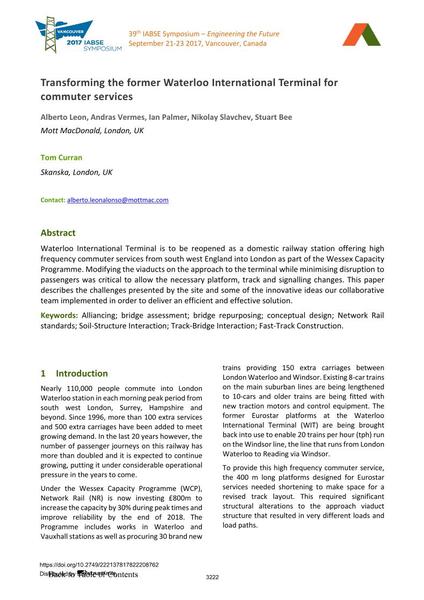Transforming the former Waterloo International Terminal for commuter services

|
|
|||||||||||
Bibliographic Details
| Author(s): |
Alberto Leon
(Mott MacDonald, London, UK)
Andras Vermes (Mott MacDonald, London, UK) Ian Palmer (Mott MacDonald, London, UK) Nikolay Slavchev (Mott MacDonald, London, UK) Stuart Bee (Mott MacDonald, London, UK) Tom Curran (Skanska, London, UK) |
||||
|---|---|---|---|---|---|
| Medium: | conference paper | ||||
| Language(s): | English | ||||
| Conference: | IABSE Symposium: Engineering the Future, Vancouver, Canada, 21-23 September 2017 | ||||
| Published in: | IABSE Symposium Vancouver 2017 | ||||
|
|||||
| Page(s): | 3222-3230 | ||||
| Total no. of pages: | 9 | ||||
| Year: | 2017 | ||||
| DOI: | 10.2749/222137817822208762 | ||||
| Abstract: |
Waterloo International Terminal is to be reopened as a domestic railway station offering high frequency commuter services from south west England into London as part of the Wessex Capacity Programme. Modifying the viaducts on the approach to the terminal while minimising disruption to passengers was critical to allow the necessary platform, track and signalling changes. This paper describes the challenges presented by the site and some of the innovative ideas our collaborative team implemented in order to deliver an efficient and effective solution. |
||||
| Keywords: |
conceptual design soil-structure interaction track-bridge interaction bridge assessment alliancing bridge repurposing Network Rail standards Fast-Track Construction
|
||||
